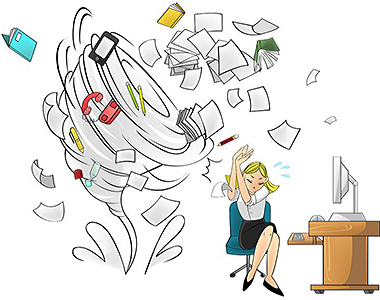 I was in the Container Store watching what seemed like hundreds of people buying all sorts of plastic containers to put their “stuff” in. It got me thinking about the types of clutter we have, particularly in the workplace. While I don’t, nor do my executive coaching clients, partake in the pathological amassing of trash you see on reality shows, we all have “stuff” and excuses for holding on to our office clutter. “My office is not immune.”
I was in the Container Store watching what seemed like hundreds of people buying all sorts of plastic containers to put their “stuff” in. It got me thinking about the types of clutter we have, particularly in the workplace. While I don’t, nor do my executive coaching clients, partake in the pathological amassing of trash you see on reality shows, we all have “stuff” and excuses for holding on to our office clutter. “My office is not immune.”
Here’s what I call executive office clutter:
E-mail Clutter: You know those e-mails you receive because once you thought the person had something interesting to say and now you delete without even opening. How many are there? Ten, fifty, more? I say, “Unsubscribe.” If you miss something after termination, sign up again.
Contact List Clutter: Names and addresses of people you don’t remember, don’t care about (or like), or who may have unfortunately even died. Each time you pass over their names you think, “I’ve got to clean this up.” Set aside some time and do it. The prize is a quality, usable list.
Electronics Clutter: The outdated Version 1.0 backup-up to the back-up piece of equipment. It could be chargers, cell phones, keyboards, hard drives, (need I continue?). Oh and don’t forget all the cords that go with them. Everyone is getting rid of their landlines but no one is throwing out the 25” phone cords that they once used in the jacks. These items take up lots of space because they are odd shapes and sizes. We also tend to store them out of sight, so if we do need one, we would have a hard time finding it anyway. My approach is to take a good long look at the piece, ask myself, “When did I last use this?” and “What has replaced it?” If I don’t have an answer for the first question, or it’s over a year, it goes. Regarding what replaced it, I really would have to have a good reason to hold on to an old backup.
Reading Clutter: The more intellectually curious you are, the easier it is to fall into this trap. Whether you tear pieces out of newspapers, download items to paper, or file them electronically, we all know the chances of you making that recipe or building that sound system, or taking the trip are slim. Even if you longed for the information months later, there’s a better chance of you finding what you saw by searching online to retrieve it, than going through the piles of magazines, files, and clippings.
People Clutter: This can be a hard one but might be the biggest energy saving opportunity of them all. There are people who clutter our lives because they demand too much, lack respect for our time and space, or take and never give. It might just be the time to cut the cord, not in a mean or vindictive way, but all the same with intent. Don’t be available or accessible, and they’ll get the message.
Desk Drawer Clutter: I think my desk drawer has reproductive abilities. One pen becomes ten. Pencils, especially those without erasers, multiply. I don’t even use rubber bands and there they are; the same paper clips. Who needs nickels? Not me, but they’re in my desk drawer! Places to stash things (such as desk drawers), are where we put stuff we think we shouldn’t throw out but have no home for. So they sit. To assist in de-cluttering, I’ve embraced what organizers call the kindergarten room approach. You know, a section for music, one for art, another for play in the classroom, become for adults, dividers for different items based on task, together in their designated section. It works and saves time.
How do you begin controlling your office clutter?
- One approach to attacking this issue is to set aside time, a de-cluttering moment, hour, or half-day. More than four hours can get boring and counterproductive.
- Another is seize a moment. I particularly like clearing out the desk drawer when placed on hold — it distracts me from that terrible music and and announcements, and makes the time go faster.
- Attacking the most distasteful task first guarantees a better day.
- I’m not above bribing myself, generally with a treat, but sometimes with a consequence like, “You can’t go to lunch until you’ve read those 10 e-mails.”
- I know of groups that schedule a team clutter attack — not necessarily in the same place. Each participant states his or her goals at the beginning and reports back accomplishments, every hour, either by e-mail or by phone. The competition and support works.
Whatever approach you take, simplifying the things in your world, including your worklife, can bring peace of mind.
If your work life seems cluttered with more than things — too many tasks, too little time, a lack of goals or direction — maybe it’s time you hired a coach. I have worked with hundreds of people who have just these issues. Want to know more? Search my website ExecutiveCoachNY.com and see what others have to say.
Leave a Reply